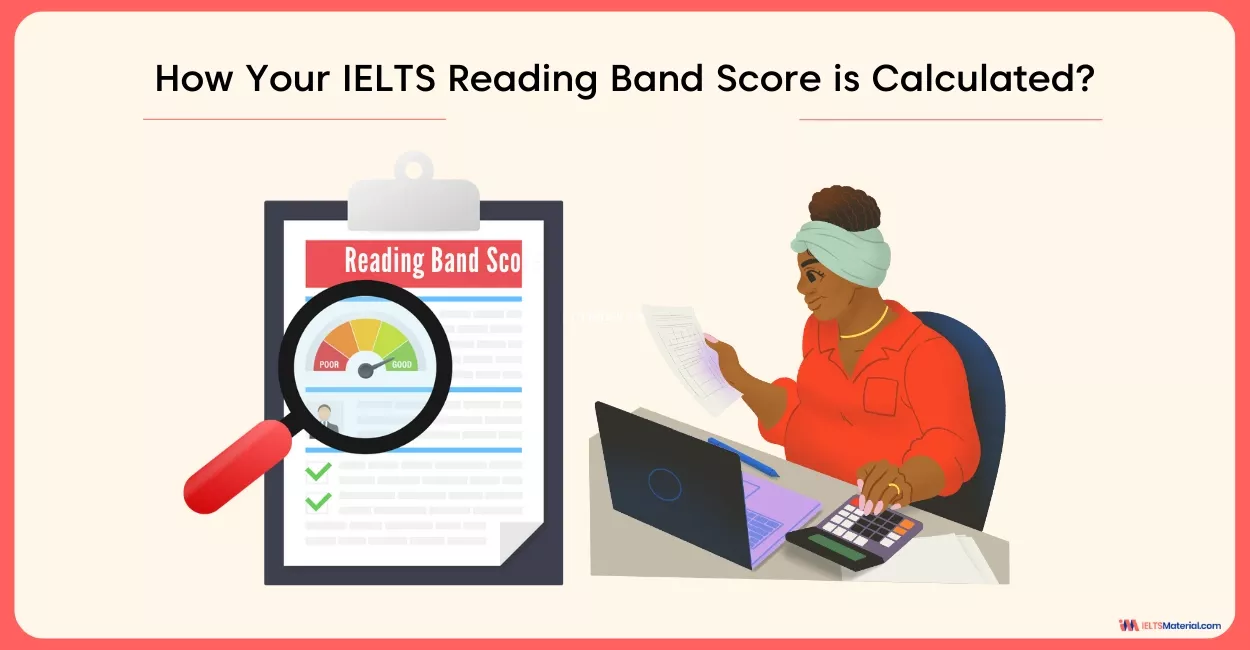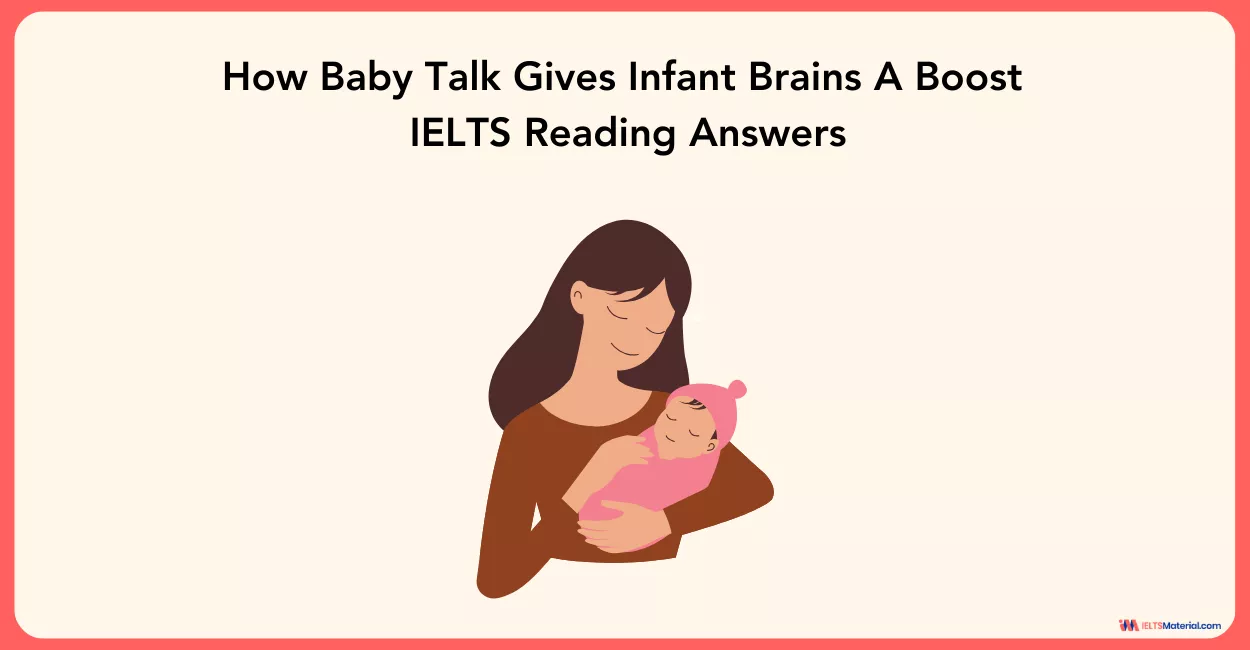How Baby Talk Gives Infant Brains A Boost IELTS Reading Answers
13 min read
Updated On
-
Copy link
Check out the 'How Baby Talk Gives Infant Brains A Boost IELTS Reading Answers passages with answer explanation and tips to effectively tackle different IELTS Reading question types, which will help you improve your reading score.
Table of Contents
- How Baby Talk Gives Infant Brains A Boost
- How Baby Talk Gives Infant Brains A Boost IELTS Reading Questions
- How Baby Talk Gives Infant Brains A Boost IELTS Reading Answers
- Tips for Answering the Question Types in How Baby Talk Gives Infant Brains A Boost IELTS Reading Answers
- IELTS Reading Matching Features (Q. 1–4)
- IELTS Reading Summary Completion (Q. 5–10)
- IELTS Reading Matching Paragraphs (Q. 11–13)

Limited-Time Offer : Access a FREE 10-Day IELTS Study Plan!
The passage “How Baby Talk Gives Infant Brains a Boost” is an actual IELTS Reading test that has appeared in past exams. Practicing such real test samples helps you understand question types, improve time management, and sharpen your reading strategies. By taking the ‘How Baby Talk Gives Infant Brains A Boost IELTS Reading Answers, you can acquaint yourself with the types of questions that you will be asked in this IELTS Academic Reading passage and the level of difficulty that you can expect. The question types in this Reading Passage include:
- IELTS Reading Matching Features (Q. 1-4)
- IELTS Reading Summary Completion (Q. 5 - 10)
- IELTS Reading Matching Paragraphs (Q. 11 - 13)
Practice the reading passage, How Baby Talk Gives Infant Brains A Boost IELTS Reading Answers, below, and for more, try IELTS reading practice tests. But, before you take the test, learn some tips from this video to get that perfect IELTS reading score!
How Baby Talk Gives Infant Brains A Boost
You should spend about 20 minutes on Questions 14-26, which are based on the Reading Passage below. Find the practice test with the How Baby Talk Gives Infant Brains A Boost PDF here.
A The typical way of talking to a baby – high-pitched, exaggerated and repetitious – is a source of fascination for linguists who hope to understand how ‘baby talk’ impacts on learning. Most babies start developing their hearing while still in the womb, prompting some hopeful parents to play classical music to their pregnant bellies. Some research even suggests that infants are listening to adult speech as early as 10 weeks before being born, gathering the basic building blocks of their family’s native tongue.
B Early language exposure seems to have benefits to the brain – for instance, studies suggest that babies raised in bilingual homes are better at learning how to mentally prioritize information. So how does the sweet if sometimes absurd sound of infant-directed speech influence a baby’s development? Here are some recent studies that explore the science behind baby talk.
C Fathers don’t use baby talk as often or in the same ways as mothers – and that’s perfectly OK, according to a new study. Mark VanDam of Washington State University at Spokane and colleagues equipped parents with recording devices and speech-recognition software to study the way they interacted with their youngsters during a normal day. ‘We found that moms do exactly what you’d expect and what’s been described many times over,’ VanDam explains. ‘But we found that dads aren’t doing the same thing. Dads didn’t raise their pitch or fundamental frequency when they talked to kids.’ Their role may be rooted in what is called the bridge hypothesis, which dates back to 1975. It suggests that fathers use less familial language to provide their children with a bridge to the kind of speech they’ll hear in public. ‘The idea is that a kid gets to practice a certain kind of speech with mom and another kind of speech with dad, so the kid then has a wider repertoire of kinds of speech to practice,’ says VanDam.
D Scientists from the University of Washington and the University of Connecticut collected thousands of 30-second conversations between parents and their babies, fitting 26 children with audio-recording vests that captured language and sound during a typical eight-hour day. The study found that the more baby talk parents used, the more their youngsters began to babble. And when researchers saw the same babies at age two, they found that frequent baby talk had dramatically boosted vocabulary, regardless of socioeconomic status. ‘Those children who listened to a lot of baby talk were talking more than the babies that listened to more adult talk or standard speech,’ says Nairán Ramirez-Esparza of the University of Connecticut. ‘We also found that it really matters whether you use baby talk in a one-on-one context,’ she adds. ‘The more parents use baby talk one-on-one, the more babies babble, and the more they babble, the more words they produce later in life.’
E Another study suggests that parents might want to pair their youngsters up so they can babble more with their own kind. Researchers from McGill University and Université du Québec à Montréal found that babies seem to like listening to each other rather than to adults – which may be why baby talk is such a universal tool among parents. They played repeating vowel sounds made by a special synthesising device that mimicked sounds made by either an adult woman or another baby. This way, only the impact of the auditory cues was observed. The team then measured how long each type of sound held the infants’ attention. They found that the ‘infant’ sounds held babies’ attention nearly 40 percent longer. The baby noises also induced more reactions in the listening infants, like smiling or lip moving, which approximates sound making. The team theorizes that this attraction to other infant sounds could help launch the learning process that leads to speech. ‘It may be some property of the sound that is just drawing their attention,’ says study co-author Linda Polka. ‘Or maybe they are really interested in that particular type of sound because they are starting to focus on their own ability to make sounds. We are speculating here but it might catch their attention because they recognize it as a sound they could possibly make.’
F In a study published in Proceedings of the National Academy of Sciences, a total of 57 babies from two slightly different age groups – seven months and eleven and a half months – were played with a number of syllables from both their native language (English) and a non-native tongue (Spanish). The infants were placed in a brain-activation scanner that recorded activity in a brain region known to guide the motor movements that produce speech. The results suggest that listening to baby talk prompts infant brains to start practising their language skills. ‘Finding activation in motor areas the baby brain is engaged in trying to talk back right from the start, and suggests that seven-month-olds’ brains are already trying to figure out how to make interesting finding was that while the seven-month-olds responded to all speech sounds regardless of language, the brains of the older infants worked harder at the motor activations of non-native sounds compared to native sounds. The study may have also uncovered a process by which babies recognize differences between their native language and other tongues.
Want to improve your IELTS Academic Reading score? Grab Our IELTS Reading Ebook Today!
How Baby Talk Gives Infant Brains A Boost IELTS Reading Questions
Questions 1-4
- Look at the following ideas and the list of researchers below.
- Match each idea with the correct researcher, A, B or C.
- Write the correct letter, A, B or C, in the boxes 1-4 on your answer sheet.
- NB You may use any letter more than once.
1. The importance of adults giving babies individual attention when talking to them.
2. The connection between what babies hear and their own efforts to create speech.
3. The advantage for the baby of having two parents each speaking in a different way.
4. The connection between the amount of baby talk babies hear and how much vocalising they do themselves.
LIST OF RESEARCHERS:
- Mark VanDam
- Nairan Ramirez-Esparza
- Patricia Khul
Questions 5-10
- Complete the summary below.
- Choose NO MORE THAN TWO WORDS from the passage for each answer.
- Write your answers in boxes 5-10 on your answer sheet.
Research into how parents talk to babies
Researchers at Washington State University used 5._____ together with specialised computer programs, to analyse how parents interacted with their babies during a normal day. The study revealed that 6._____ tended not to modify their ordinary speech patterns when interacting with their babies. According to an idea know as the 7._____ they may use a more adult type of speech to prepare infants for the language they will hear outside the family home. According to the researchers, hearing baby talk from one parent and ‘normal’ language from the other expands the baby’s 8._____ of types of speech which they can practise.
Meanwhile, another study carried out by scientists from the University of Washington and the University of Connecticut recorded speech and sout using special 9._____ that the babies were equipped with. When they studies the babies again at age two, the found that those who had heard a lot of baby talk in infancy=ncy had a much larger 10.______ than those who had not.
Questions 11-13
- Reading passage 2 has six paragraphs, A-F.
- Which paragraph contains the following information?
- Write the correct letter, A-F, in boxes 11-13 on your answer sheet.
11. A reference to a change which occurs in babies’ brain activity before the end of their first year.
12. An example of what some parents do for their baby’s benefit before birth.
13. A mention of babies’ preference for the sounds that other babies make.
Want to boost your IELTS score? Enroll in our expert-led IELTS online classes today!
How Baby Talk Gives Infant Brains A Boost IELTS Reading Answers
Let’s now review the answers to the questions from the passage in the reading section, How Baby Talk Gives Infant Brains A Boost IELTS Reading Answers, and assess your improvement for a high IELTS Reading band score.
| Question number | Answer | Explanation |
|---|---|---|
| 14 | B | Paragraph D provides the information that Nairan Ramirez Esparza said that “we also found that it really matters whether you use baby talk in a one-on-one context,’ she adds. The more parents use baby talk one-on-one, the more babies babble, the more they babble, the more words they produce later in life.” This line signifies the importance of adults giving babies individual attention. Hence, the correct answer is “B.” |
| 15 | C | Paragraph F mentions that Patrica Kuhl stated, “finding activation in motor areas of the brain when infants are simply listening is significant because it means the baby brain is engaged in trying to talk back right from the start and suggests that seven-month-old’s brains are already trying to figure out how to make the right movement that will produce words.” The above line provides details about how Kuhl claims the connection between what babies hear and their own efforts to create speech. Hence, the correct answer is “C.” |
| 16 | A | The last line of paragraph C conveys the advantages of the baby having two parents, each speaking in a different way by Mark VanDam. As he states that “the idea is that a kid gets to practice a certain kind of speech with mom and another kind of speech with dad, so the kid then has a wider repertoire of kinds of speech to practice.” Hence, the correct answer is “A.” |
| 17 | B | In paragraph D, Nairan Ramirez Esparza states that “those children who listened to a lot of baby talk were talking more than the babies that listened to more adult talk or standard speech.” Esparaza shares the connection between baby talk babies and vocalizing information. Hence, the correct answer is “B.” |
| 18 | Recording devices | The second line of paragraph C conveys that “Mark Van Dam of Washington State University at Spokane and colleagues equipped parents with recording devices and speech-recognition software to study the way they interacted with their youngsters during a normal day.” As they are equipped with a recording device, it means that researchers used a recording device. Hence, the correct answer is “recording devices.” |
| 19 | dads/fathers | Paragraph C states that “but we found that dads aren’t doing the same thing. Dads didn’t raise their pitch or fundamental frequency when they talked to kids.” From the words ‘dads didn’t raise their pitch’, we can imply that dads tended not to modify their ordinary speech. Hence, the correct answer is “dads/fathers.” |
| 20 | Bridge hypothesis | In paragraph C, the author states that “their role may be rooted in what is called the bridge hypothesis, which dates back to 1975. It suggests that fathers use less familial language to provide their children with a bridge to the kind of speech they’ll hear in public.” It suggests that fathers provide a bridge to the kind of speech that they’ll hear in public, which is known as bridge hypothesis. Hence, the correct answer is “bridge hypothesis.” |
| 21 | repertoire | In paragraph C, the last line conveys that “the idea is that a kid gets to practice a certain kind of speech with mom and another kind of speech with dad, so the kid then has a wider repertoire of kinds of speech to practice.” So kids get to practise various kinds of speech. Hence, the correct answer is “repertoire.” |
| 22 | (audio-recording) vests | The beginning line of paragraph D mentions that it “collected thousands of 30-second conversations between parents and their babies, fitting 26 children with audio-recording vests that captured language and sound during a typical eight-hour day.” The above line suggests that both universities captured language through audio-recording. It denotes that scientists of these universities are using special audio-recording vests. Hence, the correct answer is “audio-recording vests.” |
| 23 | Vocabulary | The third line of paragraph D conveys that “when researchers saw the same babies at age two, they found that frequent baby talk had dramatically boosted vocabulary.” The term ‘dramatically boosted vocabulary’ implies that infants had a much larger vocabulary. Hence, the correct answer is “vocabulary.” |
| 24 | F | In paragraph F, there’s a line that mentions that “it means the baby brain is engaged in trying to talk back right from the start and suggests that seven months old’s brains are already trying to figure out how to make the right movement.” The line is the reference to the change that occurs in babies’ brain activity. Hence, the correct answer is “F.” |
| 25 | A | Paragraph A conveys that “most babies start developing their hearing while still in the womb, prompting some hopeful parents to play classical music to their pregnant bellies.” Since some parents play classical music it signifies the example of what parents do for their baby’s benefit when it’s in the womb (before birth). Hence, the correct answer is “A.” |
| 26 | E | There’s a line in paragraph E, which mentions that “babies seem to like listening to each other rather than to adults – which may be why baby talk is such a universal tool among parents.” This confirms the babies’ preference for the sounds — the ones that other babies make. Hence, the correct answer is “E.” |
Practice with the IELTS Reading Recent Actual Tests to improve your accuracy using real exam questions and answers!
Tips for Answering the Question Types in How Baby Talk Gives Infant Brains A Boost IELTS Reading Answers
Let us check out some quick IELTS Exam Preparation Tips for Band Score of 8+ to answer the three types of questions in the Reading Answers.
IELTS Reading Matching Features (Q. 1–4)
In the Reading Matching features task, you need to match given features (e.g., names, events, theories) with statements. It tests your ability to identify relationships and spot specific details in the passage.
- Read the Features First – Familiarize yourself with the list before reading the passage so you know what to look for.
- Scan for Names/Keywords – Quickly locate where the features (e.g., people, years, theories) appear in the passage.
- Focus on Meaning, Not Just Words – Paraphrasing is common; don’t just match exact words, match ideas.
- Eliminate Wrong Options – Cross out features that clearly don’t match to narrow down choices.
- Watch for Multiple Matches – Some features may match more than one statement, so check carefully.
IELTS Reading Summary Completion (Q. 5–10)
In the Reading Summary Completion, you fill in the blanks of a summary using words from the passage. It checks your ability to understand main ideas and find accurate words.
- Identify Word Limit – Always check instructions (e.g., “NO MORE THAN TWO WORDS”) before answering.
- Read the Summary First – This gives you an overview of what information you need to find.
- Look for Paraphrased Sentences – The summary won’t copy text word-for-word; expect rephrasing.
- Predict the Missing Word – Think about grammar and meaning before searching the passage.
- Verify with Passage – Double-check that your chosen word exactly fits the context.
IELTS Reading Matching Paragraphs (Q. 11–13)
In this question type, you must match headings, ideas, or information to specific paragraphs. It tests your skill in identifying the main idea of a paragraph.
- Skim Each Paragraph First – Focus on the first and last sentences, as they often carry the main idea.
- Understand Headings/Statements – Carefully analyze the given options before matching.
- Look for Keywords & Synonyms – Match ideas, not just identical words.
- Be Aware of Traps – Some paragraphs may contain details from multiple options but only match one.
- Use Elimination – Remove options you’re sure don’t match, leaving fewer choices to compare.
Confused about IELTS prep? Join our exclusive IELTS webinar and clear all your doubts!
Mastering passages like “How Baby Talk Gives Infant Brains A Boost IELTS Reading Answers” can significantly boost your Reading IELTS band score. Regular practice with real exam-style questions not only improves speed and accuracy but also builds your confidence. Keep exploring different IELTS Reading passages and refine your techniques to ensure success on test day.
Check More IELTS Reading Answers
Also Check:
Practice IELTS Reading based on question types

Start Preparing for IELTS: Get Your 10-Day Study Plan Today!
Recent Articles

Nehasri Ravishenbagam

Haniya Yashfeen

Haniya Yashfeen

Haniya Yashfeen




Post your Comments